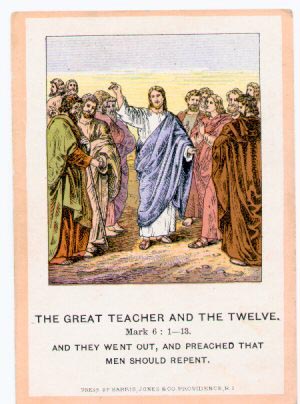

Everywhere I went I began to search for the cards. Most antique stores had no idea what I was talking about. But I managed to pick up a few at a time here and there. My big break came in 1999 when I discovered Ebay.com. I simply typed in "Bible Cards" or "Sunday School Cards" and there they were! I purchased a lot of them, usually only paying $.25 to $.50 each at first. Then other people began to discover them too. Prices went up to $.75 to $1.00 a card! Over the internet I met several other collectors and we began to trade duplicates. My collection has now grown to over 3000 different cards which I keep in 10 different albums.
My oldest Bible card is from 1880, published by David C. Cook Publishing, of Elgin, Illinois, in a group called "Illuminated Lessons".


Around the same time American Baptist Publication Society, of Philadelphia, began printing "Picture Lessons".
A few years later W. A. Wilde, of Boston, began printing the "Little Ones Quarterly".
But the big step came in 1889 when Harris, Jones & Co., of Providence, R.I., came up with the idea of using lithographs for the front. They printed their own "Little Bible Lesson Pictures" and sold the lithographs (Providence Lithograph Co.) to other publishers as well.


David C. Cook Publishing began using their own lithographs in 1895.
For a short time the Presbyterian Board of Publication used their own lithographs, but eventually went back to using those from Providence Lithographic Co.
Standard Publishing, of Cincinnati, had their own artists.
For any given Sunday date, my collection may have as many as nine different cards, with four different pictures. (These are Standard Publishing, Presbyterian Board, Providence Lithograph, and David Cook for January 6, 1901) It is possible to have as many as fifteen different cards.
(These are Standard Publishing, Presbyterian Board, Providence Lithograph, and David Cook for January 6, 1901) It is possible to have as many as fifteen different cards.
The reason it was possible to make all these cards is that there was an International Sunday School Union which decided what lessons would be taught. Virtually every Sunday School in the world used the same scripture lesson.
Divisiveness ultimately led to the demise of the use of the cards. Around 1920 different denominations split over what should be taught. The cards continued for some years later, but were inconsistent and not of the previous quality.